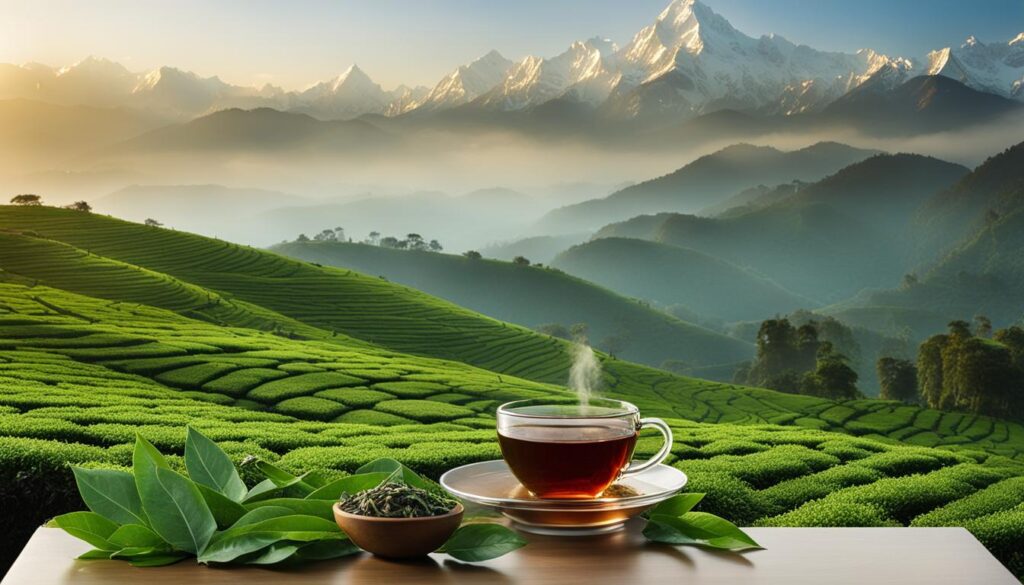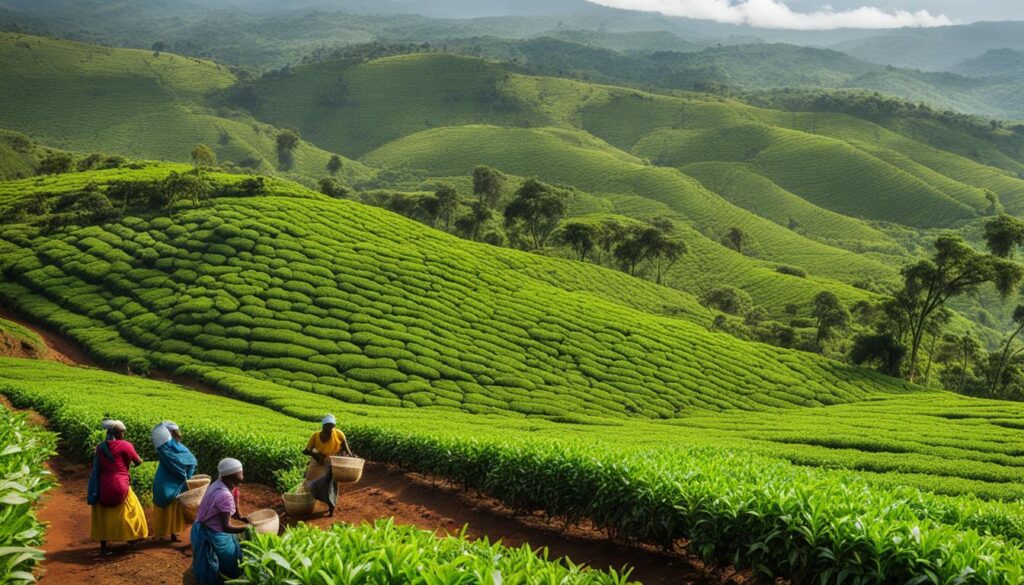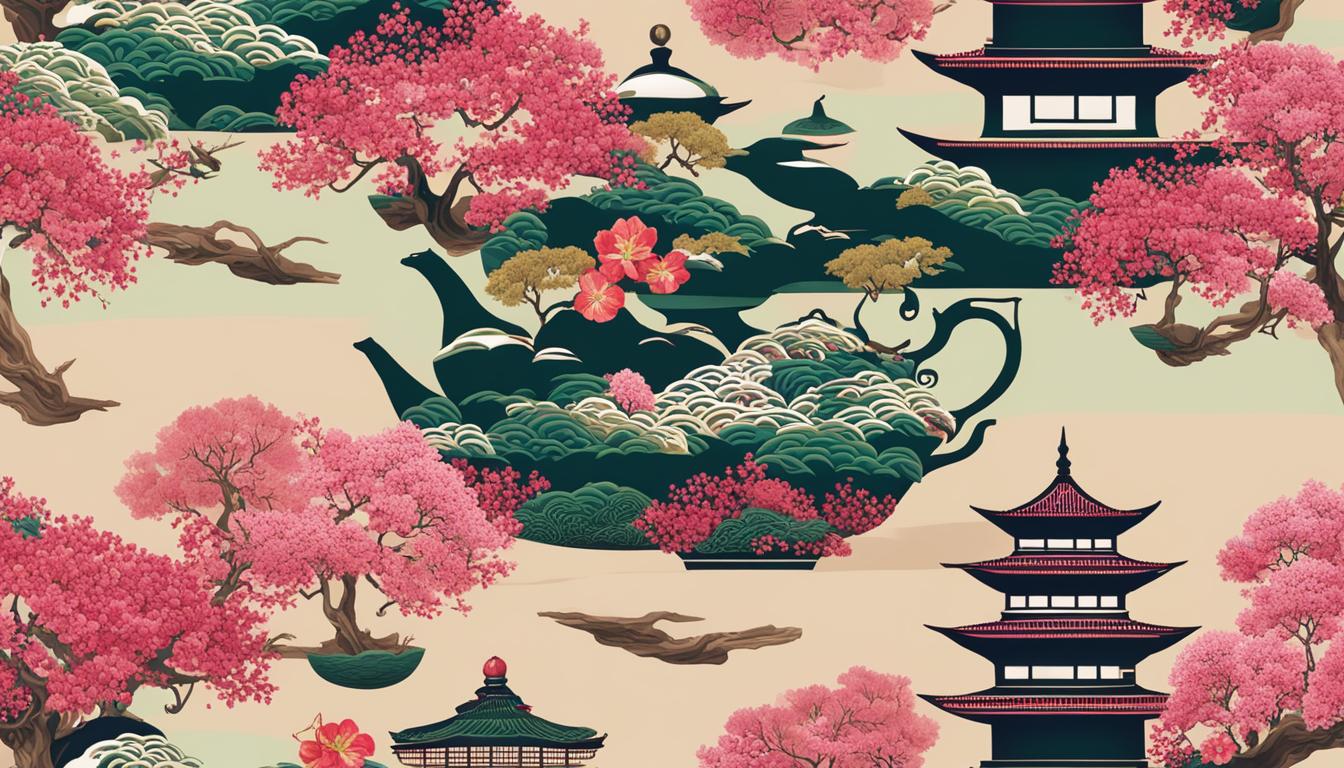Welcome to our article on the top specialties of major tea producing countries! Tea is a beloved beverage enjoyed by people all over the world, and it’s fascinating to explore the unique flavors and traditions that different countries bring to the table. Today, we’re diving into the specialties of some key tea growing nations that have made a significant impact on the global tea market.
Key Takeaways:
- China, India, Kenya, Sri Lanka, and Vietnam are major players in the global tea market.
- Each country has its own unique tea specialties and flavors.
- China is known for its diverse range of tea types, including green tea, black tea, and Oolong tea.
- India produces highly regarded teas such as Darjeeling and Assam, known for their unique flavors.
- Kenya is the largest exporter of black tea and is renowned for its high-quality tea.
Now, let’s explore the top specialties of these major tea producing countries in more detail.
China – The Home of Tea Production
China, with its rich history and tradition of tea production, is rightfully hailed as the birthplace of tea. Renowned for its diverse range of tea types, China boasts an annual production of over 2 million tons of tea. Let’s delve into the specialties that make Chinese tea so exceptional.
Green Tea
Chinese green tea is highly regarded for its distinct flavors and health benefits. Two famous varieties, Dragon Well (Longjing) and Biluochun, stand out for their fresh and grassy taste. Dragon Well, cultivated in Hangzhou, Zhejiang Province, is celebrated for its flat and broad leaves, delicate aroma, and sweet, nutty flavor. Biluochun, grown in the Dongting Mountains near Taihu Lake, offers a refreshing taste with hints of fruitiness.
Black Tea
Chinese black teas have gained global acclaim for their bold and robust flavors. Keemun black tea, hailed as the “Burgundy of Teas,” is known for its wine-like aroma, hints of orchid fragrance, and mellow taste. Lapsang Souchong, on the other hand, boasts a distinctive smoky flavor resulting from the tea leaves’ exposure to pine smoke during the drying process.
Oolong Tea
Oolong tea, with its partial oxidation, presents a wide range of flavors varying from fruity to floral. Tie Guan Yin, a famous oolong tea from Fujian Province, enchants with its orchid-like fragrance, smooth texture, and lingering aftertaste. Da Hong Pao, grown in the Wuyi Mountains, captures attention with its complex flavor profile, featuring notes of honey, roasted nuts, and ripe fruits.
| Tea Type | Notable Varieties | Flavor Profile |
|---|---|---|
| Green Tea | Dragon Well (Longjing), Biluochun | Fresh, grassy, nutty, fruity |
| Black Tea | Keemun, Lapsang Souchong | Bold, robust, wine-like, smoky |
| Oolong Tea | Tie Guan Yin, Da Hong Pao | Floral, fruity, honey, roasted nuts |
With its wide array of tea specialties, China continues to captivate and delight tea enthusiasts around the world. Whether you seek the freshness of green tea, the boldness of black tea, or the complexity of oolong tea, the teas from China are sure to offer an unforgettable experience.
India – A Melting Pot of Tea Flavors
India, the second-largest tea producer globally, is renowned for its diverse and flavorful tea specialties. Two of its most famous teas are Darjeeling and Assam tea, each offering a unique taste and aroma that tea enthusiasts worldwide admire.
Darjeeling tea, grown in the picturesque foothills of the Himalayas, showcases delicate flavors with floral undertones. This light-bodied tea is often referred to as the “champagne of teas” due to its exquisite nature. Its amber liquor, reminiscent of blooming gardens, leaves a lingering sweetness on the palate.
On the other hand, Assam tea, cultivated in the northeastern state of Assam, packs a bold and malty punch. Known for its robust flavor and deep copper hue, Assam tea is a favorite choice for breakfast teas around the world. Its strong, full-bodied character is perfect for those seeking a rich and invigorating cup to kickstart their day.
| Tea | Flavor Profile | Characteristics |
|---|---|---|
| Darjeeling | Delicate, Floral | Light-bodied, Amber liquor |
| Assam | Robust, Malty | Strong, Full-bodied, Copper hue |
Experience the magic of India’s tea flavors with Darjeeling’s gentle floral notes or embrace Assam’s hearty robustness. Each sip tells a story of the land and its people, an invitation to immerse yourself in the vibrant tapestry of Indian tea culture.
India’s tea heritage extends beyond Darjeeling and Assam, with other noteworthy teas such as Nilgiri tea, grown in the beautiful Nilgiri Hills, and Kangra tea, cultivated in the scenic Kangra Valley. Each region offers its own distinct terroir and flavor profiles, contributing to India’s reputation as a melting pot of tea flavors.
So whether you prefer the delicate elegance of Darjeeling, the boldness of Assam, or the lesser-known gems from India’s tea gardens, there is a cup of tea waiting to delight your senses and transport you to the enchanting world of Indian tea culture.

Kenya – The Leading Exporter of Black Tea
When it comes to black tea, Kenya is truly a force to be reckoned with. As the largest exporter of black tea in the world, this East African country produces an impressive 432,400 tons of tea annually. But it’s not just the quantity that sets Kenyan tea apart; it’s the exceptional quality that has earned it a well-deserved reputation among tea enthusiasts worldwide.
What makes Kenyan black tea so special? It all starts with the dedicated small-scale tea farmers who passionately nurture their tea plants to produce the finest leaves. These farmers, often working on family-owned plots of land, employ traditional methods and techniques passed down through generations, ensuring that each harvest is infused with care and expertise.
The result is a bold and full-bodied black tea that captivates the senses with its robust flavor and deep, rich aroma. The distinctive characteristics of Kenyan black tea make it a favorite choice for tea connoisseurs who appreciate the unique profile it brings to their cup. Whether enjoyed on its own or blended with other teas, Kenyan black tea adds depth and complexity to any tea-drinking experience.
Table: Key Attributes of Kenyan Black Tea
| Attribute | Description |
|---|---|
| Aroma | A deep, rich scent that is both inviting and comforting. |
| Flavor | Full-bodied with bold, robust notes that linger on the palate. |
| Color | Produces a deep amber liquor that is visually striking. |
| Caffeine Content | Contains a moderate level of caffeine, providing a gentle energy boost. |
| Harvesting Season | Primarily harvested during the dry months of January to March and June to August. |
So, the next time you’re craving a cup of black tea, consider reaching for a Kenyan blend. You’ll not only be supporting the hardworking small-scale tea farmers of Kenya but also indulging in a tea that is truly a masterpiece of flavor and craftsmanship. Cheers to the magic of Kenyan black tea!

Conclusion
As we conclude our exploration of the world’s major tea-producing countries, it becomes clear that China, India, Kenya, Sri Lanka, and Vietnam are the global leaders in the tea market. These nations not only produce vast quantities of tea but also offer a tantalizing array of unique tea specialties and flavors.
With China at the forefront, producing over 2 million tons of tea annually, it sets the standard for diverse tea types. From the fresh and grassy flavors of Chinese green teas like Dragon Well and Biluochun to the bold and robust flavors of black teas like Keemun and Lapsang Souchong, Chinese teas are renowned worldwide.
India, the second-largest tea producer, boasts its own melting pot of tea flavors. The delicate and floral Darjeeling teas, grown in the foothills of the Himalayas, and the robust and malty Assam teas from the northeastern state of Assam are just a glimpse into the rich tapestry of Indian teas.
Kenya, the leading exporter of black tea, showcases the prowess of its small-scale tea farmers. With bold and full-bodied flavors, Kenyan black teas such as Kangaita and Kericho teas have gained global recognition. Sri Lanka’s exceptional Ceylon teas and Vietnam’s simple and popular green teas also contribute to the vast diversity of the tea market.
These major tea-producing countries are not just key players but also significant contributors to the global economy. The tea industry provides livelihoods for small-scale farmers and offers a wide range of tea experiences for consumers worldwide. So, let’s raise our cups in celebration of the major tea-exporting countries, the global tea market leaders, and the largest tea producers worldwide!
FAQ
What are the top specialties of major tea producing countries?
China is known for its diverse range of tea types, including green tea, black tea, and Oolong tea. India is famous for Darjeeling and Assam teas. Kenya is the largest exporter of black tea, and Sri Lanka is known for its Ceylon teas. Vietnam specializes in green tea.
What are some famous tea specialties from China?
China is the world’s largest tea producer and is known for its wide variety of teas. Some famous specialties include Lapsang Souchong, Keemun, and Green Gunpowder. Chinese green tea, such as Dragon Well and Biluochun, is known for its fresh and grassy flavors. Black teas like Keemun and Lapsang Souchong are bold and robust in flavor. Oolong teas like Tie Guan Yin and Da Hong Pao offer a range of flavors from fruity to floral.
What are the specialties of Indian tea?
Indian tea is focused on black teas. Darjeeling tea, grown in the Himalayas, is known for its delicate and floral flavors. Assam tea, grown in the state of Assam, has a robust and malty flavor, making it popular for breakfast teas. Other famous Indian teas include Nilgiri tea and Kangra tea.
What makes Kenyan tea unique?
Kenya is the largest exporter of black tea and is known for its high-quality tea produced by small-scale farmers. Kenyan black tea is loved for its bold and full-bodied flavor, with popular varieties including Kangaita and Kericho teas.
What are the major tea producing countries and their specialties?
China, India, Kenya, Sri Lanka, and Vietnam are major players in the global tea market. Each country has its own unique tea specialties, flavors, and brewing techniques.





